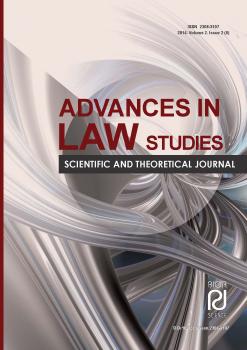Россия
Россия
Authors are dealing with the question, how the principles of the “ultimate responsibility of the State” and “primary responsibility of the licence holder”, as laid down in the multilateral international treaties, concluded under the auspices of the International Atomic Energy Agency, are reflected in inter-state transport of radioactive waste. In particular, obligations arising from the Agreement on Co-operation by Inter-State Transport of Radioactive Waste from the Czech Republic to the Russian Federation of 1998 are being subject of authors attention. With respect to this Agreement, authors are analysing delimitation of responsibilities between the state and the licence holder in the fields of safety and liability.
nuclear incident; radioactive waste management; nuclear materials; inter-state transport of radioactive waste; nuclear safety; nuclear liability
In order to facilitate the fluent transport of radioactive waste from the territory of the Czech Republic to the territory of the Russian Federation, the governments of the Czech Republic, Slovak Republic, Ukraine and of the Russian Federation signed the Agreement on Co-operation by Inter-State Transport of Nuclear Materials in 1998 (thereinafter: “the Agreement”).3 The Contracting Parties to this Agreement agreed on the necessity of the transport of radioactive waste4 through the territory of the Slovak Republic and Ukraine, which is to be realised by direct train transport. Further, the Contracting Parties explicitly acknowledged obligations arising from those multilateral treaties, they are simultaneously Contracting Parties to. These international treaties are listed in the Appendix to the Agreement as follows: the Convention on the Physical Protection of Nuclear Material of 1979,5the Convention on Early Notification of a Nuclear Accident of 1986,6 the Convention on Assistance in the Case of a Nuclear Accident or Radiological Emergency of 19867 and the Vienna Convention on Civil Liability for Nuclear Damage of 1963.8 All these treaties have been concluded under the auspices of the International Atomic Energy Agency, partly as part of its reaction to the Chernobyl nuclear accident. Basically, each Contracting Party can choose between incorporation of the obligations arising from these treaties in the domestic legal system, thus allowing for its direct application, and the adoption of national legislation specifically implementing these obligations. However, it is a matter of fact that these treaties do not bring about complete harmonisation; rather, they aim to establish some minimum standards to provide protection against damage resulting from certain peaceful uses of nuclear energy on one side and minimum standards of compensation in a case of a nuclear accident on the other side.
The international treaties, concluded under the auspices of the International Atomic Energy Agency, are reflecting the principles of the “ultimate responsibility of the State” and “primary responsibility of the licence holder (operator).”9 In this article, the authors are dealing with the question, how these principles are reflected in inter-state transport of radioactive waste. With respect to obligations arising for the Contracting parties from the Agreement, authors are analysing delimitation of responsibilities between the state and the licence holder in the fields of safety and liability.
Topical issues of nuclear security in inter-states transport of radioactive waste
Regarding to the issues of nuclear security, the Agreement explicitly refers (Art. V/1) to the security régimecreated under the Convention on the Physical Protection of Nuclear Material of 1979 (thereinafter: “the Convention on the Physical Protection”). Under the Convention on the Physical Protection, each Contracting Party shall take appropriate steps within the framework of its national law and consistent with international law to ensure as far as practicable that, during international nuclear transport, nuclear material within its territory, or on board a ship or aircraft under its jurisdiction insofar as such ship or aircraft is engaged in the transport to or from that State, is protected at the levels described in Annex I. Consequently, these levels do represent minimum standards of nuclear security and are referred to by the Agreement accordingly. Further, the Convention on the Physical Protection stipulates, that:
-
a Contracting Party shall not export/ or import or authorize the export/ or import of nuclear material unless the Contracting Party has received assurances that such material will be protected during the international nuclear transport at the levels described in Annex I.
-
a Contracting Party shall not allow the transit of its territory by land or internal waterways or through its airports or seaports of nuclear material between States that are not parties to this Convention unless the State Party has received assurances as far as practicable that this nuclear material will be protected during international nuclear transport at the levels described in Annex I.
-
a Contracting Party responsible for receiving assurances that the nuclear material will be protected at the levels described in Annex I shall identify and inform in advance States which the nuclear material is expected to transit by land or Internal waterways, or whose airports or seaports it is expected to enter.
In this regard, the Agreement provides for specific details of standards of physical protection in accordance with the Annex I. In particular, the Agreement provides for rules on ensuring the safety of transporting trains by guards, whereby guards of each of the Contracting Party are to be responsible for safety of transport regarding to the territory of the concerned Party. It is a matter of fact, that the Convention on the Physical Protection provides for an option, that “the responsibility for obtaining assurances referred to in paragraph 1 may be transferred, by mutual agreement, to the State Party involved in the transport as the importing State.” However, the Agreement does not use this option.
In this regard, while the Contracting Parties are obliged to establish corresponding legal framework and to issue corresponding administrative transit permits10, renvoi to specific agreements between private subjects is made in order to govern specific issues (e.g. requirements for security of special trains, transporting radioactive waste – Art. IV/3).
Further, the Agreement regulates also the case of potential loss of protected material (Art. V/6). In this regard, the Agreement stipulates, that responsibility for such a loss bears those Contracting Parties, under which jurisdiction did fall the respective guard in the moment of loss. In a case, the material was not protected by any guard in the moment of loss, the responsibility bears Contracting Party according to the territory.
It is a matter of fact, that major responsibilities regarding the nuclear safety by inter-state transport of radioactive waste are rendered upon Contracting Parties (States) under the international law. However, also here, the principle of “primary responsibility of the licence holder (operator) applies – in particular with regard to the obligation to cover financial costs of any safety measures, that are to be taken in this regard.
Topical issues of nuclear liability in inter-states transport of radioactive waste
Regarding to the issues of nuclear liability, the Agreement refers (Art. VI/1) to liability régime created by the ViennaConvention on Civil Liability for Nuclear Damage of 1963 (thereinafter: “the Vienna Convention”). Under the Vienna Convention, the operator is exclusively liable both where the nuclear incident occurs in a nuclear installation operated by him and where the incident occurs in the course of transport of radioactive waste to or from that installation. In the legal framework of the Convention, the operator is “the person designated11 or recognised12 as the operator of a nuclear installation by the state.” Consequently, the operator’s liability excludes the liability of the carrier, who would otherwise be liable under ordinary tort law.13 There is, however, one exception to this basic principle. Under the Convention, the Contracting Party may provide by legislation that a carrier of radioactive waste, or a person handling radioactive waste, be designated or recognised as operator in the place of the operator concerned. Further, the substitution must be requested by the carrier, or a person handling the waste, ale have theconsent of the operator concerned.14 In such a case, a carrier who is designated or recognised by the national legislation as subject liable for nuclear damage, has legally the status of the operator of the nuclear installation and shall be bound by all provisions of nuclear liability legislation. However, it is a matter of fact,15 that it is not common in the legislative practice of the Contracting Parties to channel the liability to other subjects, then the operators of nuclear installations. This legislative practice is followed also in the provisions of the Agreement (Art. VI/2), which do channel the liability for any damages arising from the course of the inter-state transport of radioactive waste to the concerned operators, holding respective licence under the Czech and Russian law.
Under the Vienna Convention, the operator of a nuclear installation from which the radioactive waste is being transported shall be liable for nuclear damage that arose during domestic transportation of radioactive waste. This is applicable till the moment when the liability is transferred to operator of another nuclear installation (e.g. the operator of a nuclear installation where the radioactive waste is being delivered and will be either temporary stored, or reprocessed in order to gain new stock of nuclear fuel). The key point is the definition of the moment when the liability is transferred from the sending operator to the receiving operator (another) respectively the determination of the moment of the transportation in which the sending operator shall be liable for nuclear damage and the moment of transportation when the receiving operator of a nuclear installation (another) will be liable for nuclear damage.Consequently, the Vienna Convention leaves the issue of transfer of liability preferentially on the will of the concerned parties (the concerned operators of nuclear installations), to agree the transfer of liability from the sending operator to the receiving operator in a written agreement (i.e. contractual transfer of liability). If such an agreement is not concluded, a dispositive provision of the Vienna Convention is applicable, that stipulates that the liability is transferred from the operator of a nuclear installation from which radioactive waste is transferred to another operator of a nuclear installation (usually the receiving operator) in the moment when another operator took over the concerned radioactive waste (i.e. statutory transfer of liability). The Agreement specifies these rules following: In case of transport of radioactive waste from the territory of the Czech Republic to the territory of the Russian Federation, the operator holding the licence under the Czech law is liable for damages until the transfer of liability, as agreed in a written agreement between both Parties. A vice versa, In case of transport of materials (in particular empty transport packages) from the territory of the Russian Federation to the territory of the Czech Republic, the operator holding the licence under the Russian law is liable for damages until the transfer of liability, as agreed in a written agreement between both Parties.
In practical terms, the application of the liability régime created by the Vienna Convention will be triggered in case of a nuclear incident. The Vienna Convention defines (Art. I) the term ‘nuclear incident’ as “any occurrence or succession of occurrences having the same origin which causes damage.” However, the nuclear third party liability regime of the Convention is applicable only to those damages, which “arises out of or results from the radioactive properties or a combination of radioactive properties with toxic, explosive or other hazardous properties of nuclear fuel or radioactive products or waste in, or of nuclear material coming from, originating in, or sent to, a nuclear installation.”16 In this regard, the Vienna Convention contains some basic liability principles, which differ considerably from the principles of the ordinary tort law:
-
Liability is legally channelled solely to the operator of the nuclear installation and is absolute. In relation to this, the Vienna Convention provides for very limited liability relief (exclusive liability of the operator). The operator will be exonerated from liability only if he proves, that the nuclear incident was directly due to armed conflict, hostilities, civil war, insurrection or a grave natural disaster, or that it resulted wholly or partly either from gross negligence of the victim of from an act or omission of the victim with intent to cause harm.
-
As a quid pro quo for the very strict conditions of the operator's liability, the Contracting Party may limit the operator's liability by the national legislation. However, the Vienna Convention provides for a minimum possible liability limit.17
-
Further, the Vienna Convention requires for congruence between operators’ liability and mandatory insurance.18
-
Operators’ liability is also limited in time.19 Since physical injury from radioactive contamination may not manifest itself for some time after the nuclear incident, the adoption of a too short period of limitation would clearly be inequitable. On other hand, this very fact, combined with the difficulty of proving that long-term radiation damage is due to a given source, has resulted in the adoption of a term shorter than those usually provided for under the general rules of tort law.
-
At the same time, the Vienna Convention provides that courts of the Contracting Party where the nuclear incident occurred will have exclusive jurisdiction over all actions brought for damages caused by a nuclear incident occurring in their territory.20 In a case where nuclear material in transport causes damage within the territory of a Contracting Party, the court where the nuclear material was situated at the time of damage will be exclusively competent.
However, it is a matter of fact, that the concept of the “ultimate responsibility of the State” is reflected also with regard to the nuclear liability. Notwithstanding the fact, liability is primary channelled to the licence holder (operator) under the Vienna Convention, the Agreement also provides for rules of the involvement of the Contracting Parties into the compensation mechanisms. Here, the Czech Republic and the Russian Federation do explicitly guarantee (Art. VI/3) the fulfilment of obligations of concerned operators to compensate damages arising from the transports covered by this Agreement. Further, in cases of operator’s exoneration from liability for nuclear damages, arising in the territory of one of the Contracting Parties, the Agreement provides for (Art. VI/4) on establishing of an inter-state commission, which will decide about prospective compensation of occurred damages.
Conclusions
Existing binding legal multilateral instruments of international law fail to provide for an exact determination between the “primary responsibility” of the licence holder and the “ultimate responsibility” of the state. Notwithstanding the “ultimate responsibility” of the state, under the polluter pays principle, the generators are responsible for managing the waste. It seems clear that licence holdersʼ “primary responsibility” entails (at least) financial responsibility (financial coverage of security measures, compensation of damages). It is commonly held that the polluters pays principle is, in the field of radioactive waste management, subject to further shaping and specification by the state and therefore its function is rather to “justify the imposition of physical or operational responsibility on waste generators.”21
In this regard, the Agreement, which establishes a kind of specific regional treaty (regional legal sub-régime) covers several gaps and harmonises certain rules concerning security and liability. It is a matter of fact, that multilateral treaties often fail to establish a robust framework with high degree of harmonisation of very sensitive issues of nuclear law.22 This is basically due to absence of worldwide consensus on specific sensitive issues. Therefore, the treaties allow deliberately space for bilateral or multilateral (regional) agreements, establishing higher standards. Consequently, the Agreement fulfils this gap, reflecting will of Contracting Parties for mutual co-operation in the field of peaceful uses of nuclear energy.
1. Blanchard, P. Responsabilité civile nucléaire et transports internationaux : retour sur un demi siècle d’incertitudes. In: AIDN/INLA (ed.) Nuclear inter Jura 2009, Toronto : AIDN/INLA, 2009, pp. 410-425.
2. Blix, H. The Role of the IAEA in the Development of International Law. Nordic Journal of International Law. Vol. 58, Issue 2, 1989, pp. 231-245.
3. Brown, O., Horbach, N. Liability for International Nuclear Transport: An Overview. In: OECD (ed.) Reform of Civil Nuclear Liability. Paris: OECD, 1999, pp. 237-262.
4. Calderon-Alner, C. Traitements conventionnels de la responsabilité civil nucléaire transport : pathologies et remèdes. In : AIDN/INLA (ed.): Nuclear Inter Jura 2007, Brussels : Bruylant, 2008, p. 485-514.
5. Hardy, M. International Protection Against Nuclear Risks, International and Comparative Law Quarterly, Vol. 10, Issue 4, 1961, pp. 651-678.
6. Horbach, N. Nuclear liability conventions and transport: an overview. In IAEA (ed.): International Conference on the Safety of Transport of Radioactive Material, Vienna: IAEA, 2003, pp. 11-13.
7. Horbach, N., Blanchard, P. Responsabilité civile nucléaire des transports internationaux: questions nouvelles et propositions. In: Revue de Droit des Affaires Internationales. Issue 5, 2006, pp. 633-662.
8. Jenkins, B. Establishing international standards for physical protection of nuclear material. The Nonproliferation Review. Vol. 5, Issue 3, 1998, pp. 98-110.
9. Leigh, W. Gaps in the Current Nuclear Liability Regime with Particular Regard to Transport. In : OECD (ed). Reform of Civil Nuclear Liability, Paris : OECD, 2000, pp. 285-297.
10. Ludbrook, J. Liability in the transport of nuclear material: existing liability regimes and gaps in their coverage. In: IAEA (ed.) International Conference on the Safety of Transport of Radioactive Material. Vienna: IAEA, 2003, pp. 15-18.
11. Magnus, U. Intercontinental Nuclear Transport from the Private International Law Perspective. In: OECD (ed.) Reform of Civil Nuclear Liability. Paris: OECD, 1999, p. 263-284.
12. Dorothee Nardi. Transport of radioactive material. In: International Journal of Nuclear Law. Vol. 3, Issue 3, 2010, pp. 33-64.
13. Rainaud, J. Le Droit Nucléaire, Paris : Presses Universitaires de France, 1994.
14. Reyners, P. The modernisation of the international nuclear liability regime: its impact on transport operations. In: IAEA (ed.) International Conference on the Safety of Transport of Radioactive Material. Vienna: IAEA, 2003, pp. 19-28.
















